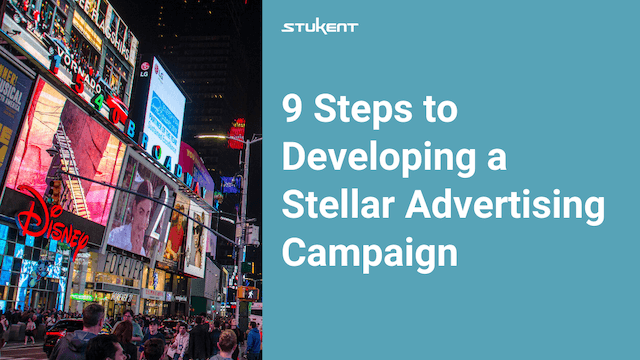When you think of an advertising campaign, what comes to mind? A funny Super Bowl commercial for Amazon? The North Face ads that appear in your Instagram feed? A jingle you heard on the radio for your local furniture store?
Whatever it may be, as a consumer, you see the final product of what can be months of planning and preparation. Developing advertising campaigns is a fun, creative, and dynamic process, but it certainly takes time, skill, and money. In fact, according to Statista, global ad spend reached over $563 billion in 2019.
In a saturated advertising market where 47 percent of internet users implement ad blockers, how will your students cut through the noise and develop memorable and effective ad campaigns?
According to “Advertising: Selling in Today’s World,” students can follow a nine-step process to create successful advertising campaigns.
1. Problem Definition
Clearly define the problem.
Find the why behind your advertising. Explain the problem in the simplest way you can, then develop the rest of your advertising campaign around it.
Let’s use a hypothetical situation. Rain or Shine, a high-end clothing boutique that sells sustainably sourced apparel, is losing business to the local Forever 21.
That’s the problem definition.
2. Research
Understand the problem and the consumer.
According to Brandwatch, “The aim of advertising research is to understand your customers and their motivations better so that you can produce better ads that demonstrate why your product meets their needs.”
Per the previous example, Rain or Shine would want to determine why they were losing customers to Forever 21.
Do people prefer to purchase cheaper clothing? Do they value price over quality? Is the location of Forever 21 more convenient than the location of Rain or Shine? Is Forever 21 better at keeping up with trends? Do customers prefer shopping at a large retail store? What is Forever 21 doing that Rain or Shine is not? Can Rain or Shine meet the needs of customers in the same way Forever 21 does or even better? What opportunities and threats exist for Rain or Shine?
Advertisers can use tools like the following to conduct primary and secondary research:
- SurveyMonkey
- Google Analytics
- Answer the Public
- Quora
- Google Trends
- Consumer Barometer
- Government data
- Twitter Insiders
After conducting primary and secondary research, advertisers can then create situation and SWOT analyses. Usually, a situation analysis includes:
- Category dynamics — major trends in the category
- Competitive sales analysis — standing in the category
- Target users — audience’s behaviors and attitudes
- Geography — strengths and weaknesses
- Seasonality — the effects on business due to time
- Purchase cycle — the frequency of purchases
- Competitive media spending — the brands consumers hear from most
- Competitive advertising analysis — the messages from those brands
- SWOT analysis — strengths, weaknesses, opportunities, and threats
Classroom Application
The SWOT analysis is usually depicted as a matrix like the one below. Have your students conduct a SWOT analysis for Rain or Shine or a company of their choice.
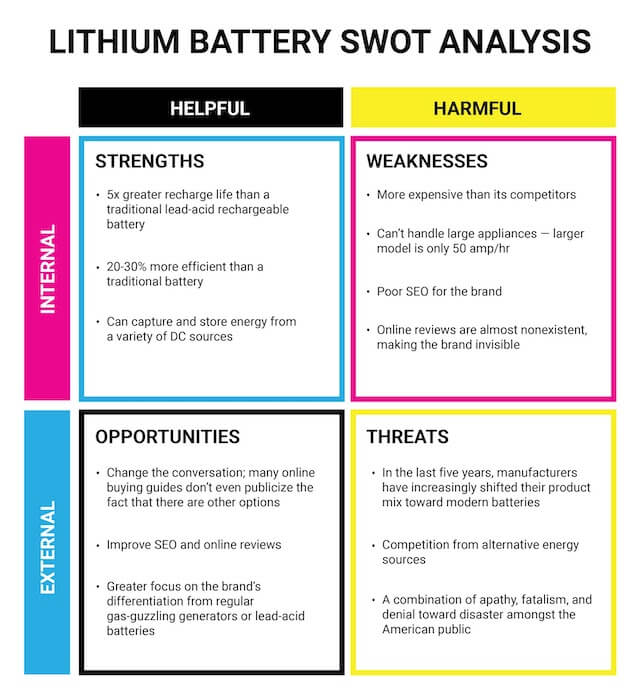
3. Objective and Strategy Development
Determine what you want to accomplish and how you will accomplish it.
An objective is a goal, and a strategy is the action taken to accomplish that goal. Advertisers should determine specific, measurable, achievable, relevant, and time-oriented (SMART) objectives.
For example, Rain or Shine’s objective could be to increase sales by 5 percent over the next year. Its strategy could be to help customers understand the unique value of sustainably sourced, durable clothing.
In the case of larger corporations, “Advertising: Selling in Today’s World,” says, “When the advertising process is working properly, the corporate objectives will inform the department objectives, which in turn will inform the subdepartment objectives. Everybody is pulling in the same strategic direction.”
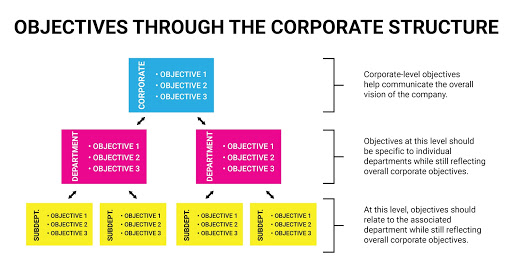
4. A Communications Brief
Explain the message to be communicated.
A communications brief (sometimes called a creative brief) is a written document that contextualizes the objective, target audience, proposition, tonality, and other elements of an advertisement, and it helps the teams developing an advertising campaign understand the message to be communicated.
HubSpot suggests that creative briefs include a description of:
- The brand and its background
- Its challenges and objectives
- Its target audience
- The competitive landscape
- A distribution plan
Classroom Application
HubSpot also provides a handy template to get advertisers started on a communications brief. Copy and paste it into your own document, and turn it into an assignment. Have your students fill it out as if they were running an advertising campaign for Rain or Shine or a company of their choice.
[Inset Company or Client Logo at top]
COMPANY BACKGROUND:
For ___ years, ______ [Brand Name] has been serving customers in the ____________ [group/job field/geographical area] with ____________________ [product or service].
[Brand Name] has made achievements including __________, __________, and ___________. We have also launched marketing campaigns that have touched on ________, ________, and ____________. With the launch of _________ [project name] they hope to ___________.
CHALLENGE/OBJECTIVE:
With this project, the company aims to solve problems related to ____________________, while also expanding on ___________ and improving on _____________.
TARGET AUDIENCE:
Our target audience is ____ [gender], in the age range of _ and _, and live in areas like ____, _____, and ______. They enjoy _____, dislike ______, and might work in fields like _____, _____, and _____. They want more of ________ and their daily pain points include ________.
Their favorite products might include _______ and ______. They learn about these products through channels including ________, _________, and _______.
COMPETITION:
Our three biggest competitors [are/will be] ________, ________, and _______. These competitors offer _____, ______, and ______. We are ahead of them in _____ and ______, but we are behind when it comes to product offerings like __________ and _________.
DISTRIBUTION:
We will promote the launch on platforms and channels that our demographic regularly engages with. These will include ________, ________, and _______.
We will also release content including _______, _______, and ________ to gain attention from our audience and inform them of the project.
Below are a few messages we will use:
_________________________________________________.
_________________________________________________.
_________________________________________________.
5. Media Planning and Buying
Determine the media vehicles you will use to reach your target audience.
Media planning is the process of choosing an individual media — or mix of media — in which to run a message. For example, Rain or Shine might choose to target 20- to 30-year-old females via social media.
The type of media or media mix a company chooses to purchase for an advertising campaign largely depends upon consumers’ media habits. Here are just a few ways consumers can be exposed to messages:
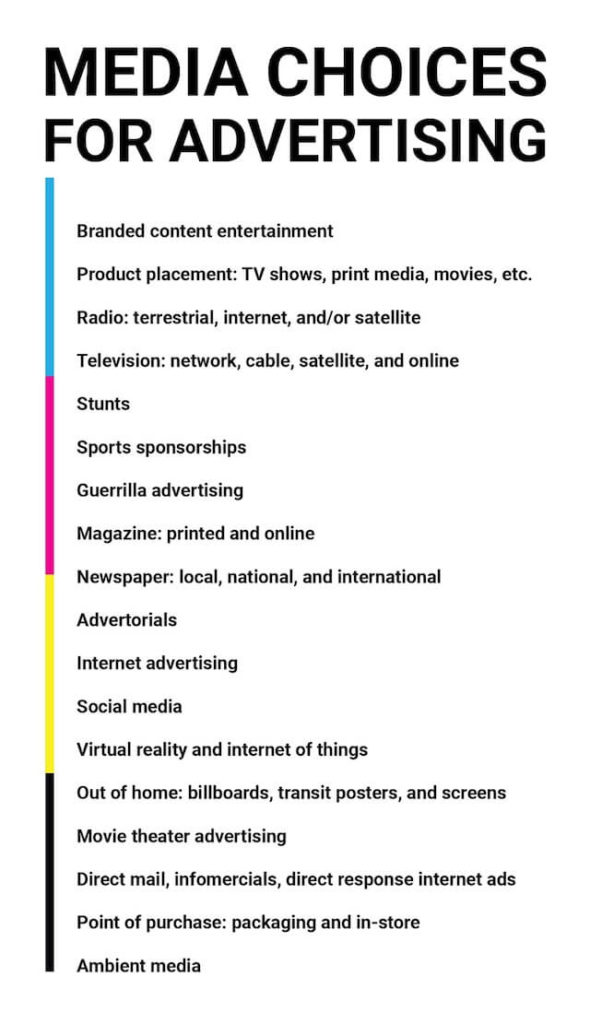
Companies have the option to use paid, owned, or earned media. Paid media is purchased from a media publisher. Owned media is owned by the companies themselves, and earned media is media coverage that a company does not pay for. All three are uniquely important to advertising campaigns.
Classroom Application
Review LinkedIn’s “Media Planning vs. Media Buying: Strategic Concerns” with your students to learn more.
6. Creative Development
Communicate in the most impactful way.

Creative development all begins with an idea because people connect with ideas not ads. Many advertisers get caught up in building an ad and forget to focus on their audiences.
There are hundreds of ways to go about developing a creative idea, however James Webb Young developed a five-step process about 100 years ago that is still used today.
- Immersion — Dive into all of the details of the brand, competition, and audience.
- Digestion — Determine what is most important.
- Incubation — Leave it be and let your subconscious take over.
- Illumination — Let ideas flow freely.
- Reality testing — Run your ideas by others to find the ones that perform best.
7. Production
Create ads.
Once a creative concept has been approved, it’s time to create an ad. A good ad has a powerful headline and visuals, resonates with the brand and its tagline, and tells a story. Writers and designers generally take on the majority of ad production.
Writers should remember that headlines capture the attention of a consumer and build intrigue, while taglines portray the meaning of a brand, and body copy tells the story. Designers can easily get lost in the creative process, but it is important to stay focused on the brand and its product.
Here are a few examples of powerful advertisements:

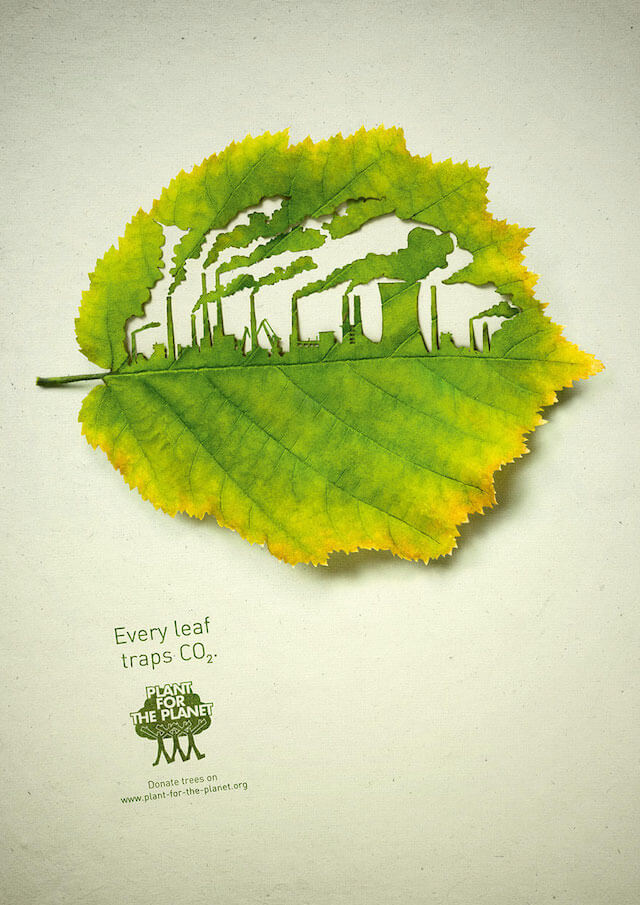
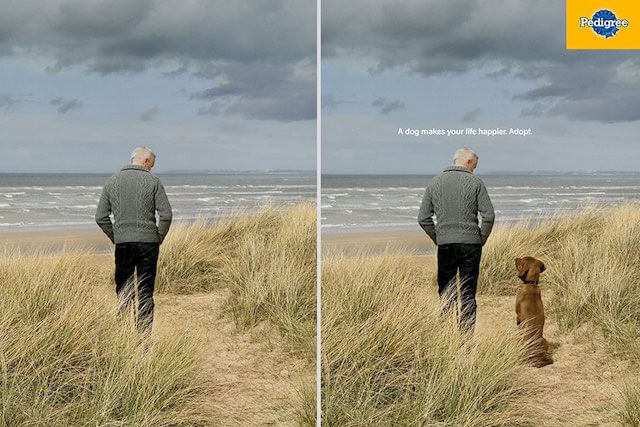
Classroom Application
Have your students create a photo ad for Rain or Shine or a company of their choice, using a free design tool like Canva. Share Canva’s “30 advertisement design tips that turn heads” to give your students direction.
8. Testing
Test the performance of your ads.

Before running an advertisement, you’ll want to make sure it’s meeting your objectives and communicating the desired message.
Share the advertisement with select consumers and ask what message they pulled from it. If their answers don’t match the intended message, you’ll have to rethink your creative development.
Have your students share the photo ads they made during Step 8 with one another to determine whether their designs communicated the intended messages.
9. Running the Advertising and Evaluating Effectiveness
Analyze your ads and maximize return on investment (ROI).
Advertisers use key performance indicators (KPIs) to measure how well communications objectives are met. In Rain or Shine’s case, the KPIs could be sales, conversions from Forever 21 to Rain to Shine, or even brand sentiment. Most advertising campaigns require a measurement of return on investment, which is the number of sales gained as a direct result of an investment. For every $1,000 Rain or Shine invests in advertising, it may see a $5,000 increase in sales.
Along with determining and tracking KPIs, advertisers should conduct attribution. Attribution is the process of assigning a value to each touchpoint a consumer has with a brand in terms of its ability to contribute to the final sale of a product. Attribution helps companies understand which advertising efforts are most effective.
By correctly defining and measuring the success of an advertising campaign, companies can see the relationships between various touchpoints and determine the value of their advertising efforts.
Get Free Access to “Advertising: Selling in Today’s World”
With the help of these nine steps, your students are well on their way to developing stellar advertising campaigns. For more information, request free instructor access to “Advertising: Selling in Today’s World.”
It provides an in-depth look at all things advertising and gives students hands-on learning experiences that prepare them for a competitive job market.
“Advertising: Selling in Today’s World” comes complete with lesson plans, lecture slides, assignments, projects, and more, making your life simpler. It is also updated twice-a-year to keep your course current and reflect the latest industry trends. Get free access today, and start saving hours of prep time!
